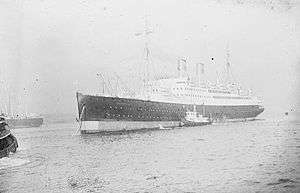MS Gripsholm (1924)
 Gripsholm in her original black-hulled livery. | |
| History | |
|---|---|
| Name: | Gripsholm (1925-1954) Berlin (1954-1966) |
| Owner: | Swedish American Line (1925-1954), North German Loyd (1954-1966) |
| Builder: | Armstrong Whitworth & Co. Ltd. |
| Launched: | 1924 |
| Maiden voyage: | 1925 |
| Fate: | Scrapped in 1966 |
| General characteristics | |
| Type: | Passenger liner |
| Tonnage: | 17,993 GRT |
| Length: | 573 ft (174.7 m) |
| Beam: | 74 ft (22.6 m) |
| Installed power: | Burmeister & Wain diesels |
| Propulsion: | Two shafts |
| Speed: | 16 knots (30 km/h; 18 mph) |
| Capacity: |
127 first class 482 second class 948 third class |
| Crew: | 360 |
| Notes: | [1] |
MS Gripsholm was an ocean liner, built in 1924 by Armstrong Whitworth in Newcastle-upon-Tyne, England, for the Swedish American Line for use in the Gothenburg-New York City run. She was of great historical importance as the first ship built for transatlantic express service as a diesel-powered motor vessel, rather than as a conventional steamship. Within forty years, however, all major passenger vessels would be diesel-powered.[2]
From 1927 onwards, the Gripsholm was used as a cruise ship alongside transatlantic crossings. From 1942 to 1946, the United States Department of State chartered Gripsholm as an exchange and repatriation ship, carrying Japanese[3] and German nationals to exchange points where she then picked up US and Canadian citizens (and British married to Americans or Canadians) to bring home to the USA and Canada. In this service she sailed under the auspices of the International Red Cross, with a Swedish captain and crew. The ship made 12 round trips, carrying a total of 27,712 repatriates. Exchanges took place at neutral ports; at Lourenço Marques in Mozambique or Mormugoa in Portuguese India with the Japanese, and Stockholm or Lisbon with the Germans.
After the war, Gripsholm was used to deport inmates of US prisons to Italy and Greece.
The Swedish American Line sold Gripsholm to Norddeutscher Lloyd in 1954, who renamed her MS Berlin.
The ship was sold for scrap in 1966.
References
- ↑ The First Great Ocean Liners (pg 116) William H. Miller 1984 General Publishing Co. Ltd Canda
- ↑ Maxtone-Graham, John (1997). The Only Way to Cross. New York City: Barnes & Noble. p. 252. ISBN 978-0-76-070637-4.
- ↑ Elleman, Bruce (2006). Japanese-American civilian prisoner exchanges and detention camps, 1941-45. Routledge. p. 31. ISBN 978-0-415-33188-3. Retrieved 14 September 2009.
External links
- The Great Ocean Liners: Gripsholm (I)
- A Tribute to the Swedish American Line: Gripsholm 1925-1954
- (Swedish) Fakta om Fartyg: MS Gripsholm (1925)